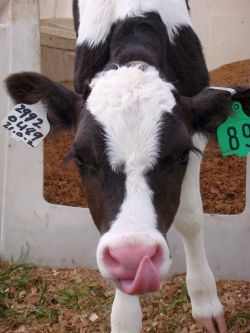
When Shawn Saylor was in high school, he built a science-fair-sized solar-powered home, complete with tiny solar cells and working lights. (He got an A.) These days, Saylor is a fourth-generation dairy farmer working on an entirely different renewable energy project.
 The Hillcrest Saylor Dairy Farm in Rockwood, Pennsylvania, produces some 6,000 gallons of milk a day. But the farm’s other export isn’t made in a milking room — it’s made in an underground tank 16 feet deep and 70 feet in diameter. Saylor describes his methane digester as a “high-efficiency stomach” processing the leftover energy the cows weren’t able to digest.
The Hillcrest Saylor Dairy Farm in Rockwood, Pennsylvania, produces some 6,000 gallons of milk a day. But the farm’s other export isn’t made in a milking room — it’s made in an underground tank 16 feet deep and 70 feet in diameter. Saylor describes his methane digester as a “high-efficiency stomach” processing the leftover energy the cows weren’t able to digest.
This energy is enough to power the entire farm with kilowatts to spare — kilowatts that Saylor can sell back to the grid. Saylor’s methane project also receives support from state grants and a partnership with Native Energy, a company selling renewable energy credits to consumers and businesses. But even without these incentives, Saylor says, the project will pay for itself within five years.
More than this, though, Saylor is excited about the closed-loopedness of the whole process. His cows produce manure that is sent to the underground tank for 15-20 days where anaerobic bacteria create methane gas; that gas is collected and used to run generators that power the farm. Meanwhile, the leftover (and thoroughly dried) manure is composted and used as organic fertilizer; that fertilizer is applied to the grains grown on the farm and then fed to the cows — who, in turn, produce more manure, of course. And throughout the process, heat-exchange systems help increase overall efficiency.

But Saylor is anxious to take even further advantage of his methane-digester system. He’s looking into using the methane gas to power some of the farm’s vehicles, and he’s already purchased a second generator that can be used exclusively to sell power back to the grid.
As Todd and I toured the farm, cooing at baby calves while marveling at the sheer amount of waste their mothers produce, we found it refreshing to talk to someone so passionate about his work and eager to spread the word about the system’s success. Below, some highlights from our conversation:
